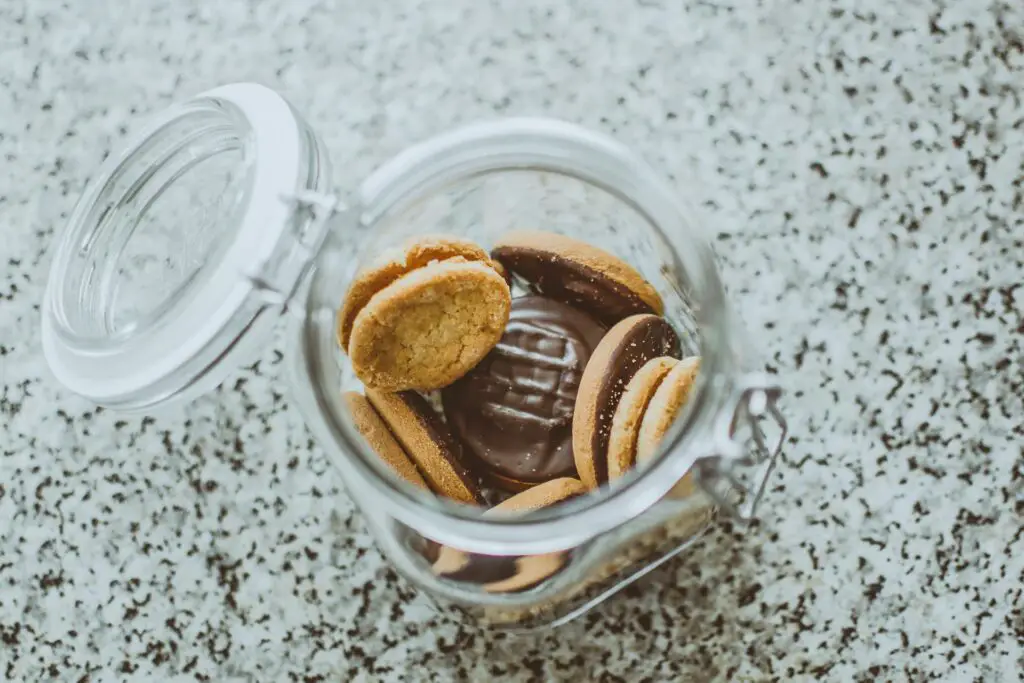Nothing ruins a batch of homemade cookies faster than waking up to find them tough, stale, or worse—mysteriously soggy.
You spent the time mixing, scooping, and baking, only to lose the magic overnight. The good news? You can keep that fresh-from-the-oven taste alive.
This guide shows you how to store cookies the right way, whether you love them soft and chewy, crisp and crunchy, or topped with gooey frosting.
Each type needs a slightly different approach, but once you know the tricks, your cookies will stay delicious far longer.
Understand Your Cookie Type
Before you can store cookies properly, you have to know what kind of cookies you’re working with. Not all cookies behave the same once they leave the oven.
Some dry out faster than you can say “chocolate chip,” while others soak up moisture like a sponge at the bottom of the sink.
Knowing the difference is the first step to keeping them fresh.
Soft & Chewy Cookies
Think of chocolate chip, snickerdoodles, or oatmeal raisin. These cookies are packed with moisture, which is why they taste so soft and gooey when fresh.
The downside? That same moisture escapes quickly if they’re left exposed. A chewy cookie can turn into a hockey puck overnight if it’s not sealed up tight.
To protect their texture, they need airtight storage and sometimes a little moisture “helper” (like a slice of bread in the container) to keep them tender.
Crisp & Crunchy Cookies
Now picture biscotti, shortbread, or gingersnaps. These cookies are baked longer, giving them a crisp bite. Their enemy isn’t air—it’s humidity.
The moment they absorb moisture, they lose their snap and become limp or chewy.
Storing them in a dry place with some airflow (not completely airtight) helps them keep that satisfying crunch.
If you’ve ever left shortbread in a plastic container too long and found it tasting oddly soft, you know exactly what’s at stake here.
Frosted or Filled Cookies
Cookies topped with icing, dipped in glaze, or stuffed with cream are a category of their own. They’re delicious, but they bring extra challenges.
Frosting can stick, smudge, or turn soggy if packed poorly. Fillings can spoil quickly if left at room temperature, especially if dairy-based.
These cookies often need to be layered carefully with parchment paper and sometimes even refrigerated.
The trick is to balance food safety with flavor so the toppings don’t ruin the cookie beneath.
General Storage Principles
Before you even think about containers, the first rule is patience—cookies must cool completely before storing.
Tucking warm cookies into a jar or box traps steam, and that moisture quickly turns into sogginess or sticky tops.
Once cooled, airtight containers become your best friend because air is what dries cookies out and steals their flavor.
Think of it as putting a little protective bubble around your treats. But don’t toss all your cookies in together like a mixed bag of laundry—strong flavors spread fast.
A bold ginger snap will happily share its spice with a delicate vanilla wafer, and suddenly everything tastes the same.
Keep similar flavors together, and you’ll preserve both freshness and individuality.
These three principles—cool completely, seal tightly, and separate flavors—sound simple, but they’re the backbone of keeping every cookie tasting exactly as it should.
Best Ways to Store Soft & Chewy Cookies
Soft and chewy cookies are all about that tender bite, so your goal is to lock in their moisture without letting them dry out.
The best trick is to place them in an airtight container with a slice of bread or even a wedge of apple—both release just enough moisture to keep the cookies soft while sacrificing themselves in the process (the bread goes stale, but the cookies stay perfect).
Keep the container at room temperature and away from direct sunlight or heat, because warmth speeds up staleness and sunlight can mess with flavor.
Whatever you do, resist the urge to refrigerate—cold air actually sucks the life out of chewy cookies and makes them firm and unappetizing.
With this method, your chocolate chips, snickerdoodles, and oatmeal raisin cookies will stay pillowy and fresh for days instead of hours.
Best Ways to Store Crisp & Crunchy Cookies
Crisp cookies live and die by their snap, so the key is keeping them far away from moisture.
Instead of locking them up tight like chewy cookies, store them in loosely covered containers or old-fashioned tins lined with paper towels, which help absorb any stray humidity without turning them limp.
Never mix them with softer varieties, because one batch of chewy chocolate chips will send enough moisture to make your biscotti soggy in no time.
Keep these crunchy treasures in a cool, dry spot—think pantry shelf, not on the counter next to the kettle or dishwasher, where steam sneaks in and ruins the texture.
Follow these steps and your shortbread, biscotti, or gingersnaps will keep their satisfying crunch for days, ready to dunk, nibble, or snap with pride.
Storing Frosted, Glazed, or Filled Cookies
Cookies topped with frosting, drizzled with glaze, or stuffed with creamy centers need a little extra TLC because they’re messy, delicate, and prone to sticking together.
Always store them in a single layer if possible, or if you must stack, use parchment paper between each layer so the icing doesn’t glue one cookie to the next.
If the frosting or filling has dairy—like cream cheese icing or whipped cream, you’ll want to refrigerate them for safety, even if it means sacrificing a bit of softness.
Just remember that cold air dulls flavors and makes textures stiff, so let them return to room temperature before serving.
That quick rest brings back the smooth frosting, the right chew, and the flavor you were excited about in the first place.
Handled this way, decorated cookies look neat, taste fresh, and won’t leave you with a sticky cookie blob at the bottom of the container.
Freezing Cookies for Long-Term Freshness
Freezing is your secret weapon when you want cookies that taste freshly baked weeks—or even months—later. The big decision is whether to freeze dough or baked cookies.
Freezing dough saves space, lets you bake only what you need, and gives you that amazing “fresh-out-of-the-oven” experience whenever the craving hits.
On the other hand, freezing baked cookies is quicker and means you always have a ready-to-eat stash on hand, though they may lose just a touch of texture compared to dough.
When freezing baked cookies, wrap each one individually in plastic wrap or parchment to prevent freezer burn, then place them in a sturdy freezer bag or airtight container.
Don’t forget the label with the date, because mystery cookies buried under frozen peas six months later aren’t nearly as exciting.
For dough, scoop it into balls first and freeze them flat on a tray before transferring to a bag—this keeps them from fusing into one giant cookie rock.
When it’s time to enjoy, thaw baked cookies at room temperature for the best texture, or give them a quick warm-up in the oven or microwave to bring back that just-baked feel.
Frozen dough can go straight into the oven—just add an extra minute or two of baking time.
With these tricks, your freezer becomes less of a storage space and more of a time machine for fresh cookies on demand.
Common Mistakes to Avoid
Mixing Different Cookie Types in One Container
It might seem easier to toss all your cookies into one tin, but that shortcut usually backfires.
Soft cookies release moisture, which makes crisp cookies soggy, while crunchy ones can dry out the chewy ones.
On top of that, flavors mingle—your buttery shortbread can start tasting like ginger snaps or peppermint. Keep each type in its own container to protect texture and taste.
Storing Warm Cookies
Patience pays off. If you store cookies while they’re still warm, the trapped steam turns into condensation, and suddenly your perfect batch is sticky, limp, or even mold-prone.
Always let cookies cool completely on a rack before storing them. Think of it as letting them “catch their breath” before being tucked away.
Forgetting to Label Freezer Bags
The freezer is a cookie lover’s best friend, but it can quickly turn into a mystery box if you don’t label your bags.
Six months later, you might pull out something that looks like a chocolate chip but turns out to be oatmeal raisin—or worse, freezer-burned leftovers from who-knows-when.
A simple date and description on the bag saves you from confusion and disappointment.
How Long Cookies Last (Shelf Life Guide)
Soft Cookies
Soft and chewy cookies—like chocolate chip, snickerdoodle, or peanut butter—are best enjoyed fresh.
At room temperature, they’ll stay soft for about 2–4 days if stored properly in an airtight container with a slice of bread to help maintain moisture.
For longer storage, freeze them for up to 3 months. When thawed or briefly warmed, they’ll taste nearly as good as the day you baked them.
Crisp Cookies
Crisp cookies, such as biscotti, shortbread, or gingersnaps, hold their texture a little better. When kept in a dry container, they’ll last 1–2 weeks at room temperature without losing too much crunch.
If you want to extend their life even further, the freezer is your ally—properly stored, they can stay crisp for up to 6 months.
Just make sure they’re kept away from moisture during thawing, or you’ll trade that crunch for chew.
Frosted or Filled Cookies
Cookies with frostings, glazes, or creamy centers are a bit more high-maintenance.
Because of their toppings or fillings—especially dairy-based ones—they should be stored in the fridge and eaten within 2–3 days to keep them safe and tasty.
For longer storage, they can be frozen for about 1–2 months.
The key here is to thaw them slowly and let them come back to room temperature before serving, so both the cookie and the topping taste their best.
Final Words
Keeping cookies fresh isn’t rocket science—it’s about pairing the right container with the right environment.
Soft ones need airtight love, crisp ones need dry space, and frosted ones need a little extra care.
Try out different tricks, whether it’s slipping in a slice of bread or freezing a small batch for later.
Tried these storage tips? Tag us with your fresh cookie stash—we’d love to see it!
FAQs
Can I store different cookie types in one container?
It’s best not to. Soft cookies release moisture, which makes crisp cookies lose their crunch. Plus, strong flavors can blend together. Keep each type separate to preserve texture and taste.
Is it better to freeze dough or baked cookies?
Freezing dough usually gives you the freshest results since you bake it right before eating. Freezing baked cookies works too, but they may lose a bit of texture over time.
Both methods are handy depending on your needs.
How do I keep cookies from sticking together?
Use parchment paper between layers, especially for frosted or filled cookies. For plain cookies, a little space in the container goes a long way in preventing clumps.
Can I store cookies in glass jars?
Yes, but only for short-term storage. Glass jars look pretty, but they’re not always airtight. If you’re keeping cookies for more than a day or two, use proper containers to lock in freshness.
Do cookies stay fresher if vacuum-sealed?
Absolutely. Vacuum sealing removes most of the air, which slows down staleness and freezer burn. It’s especially useful if you plan to freeze cookies for months at a time.



